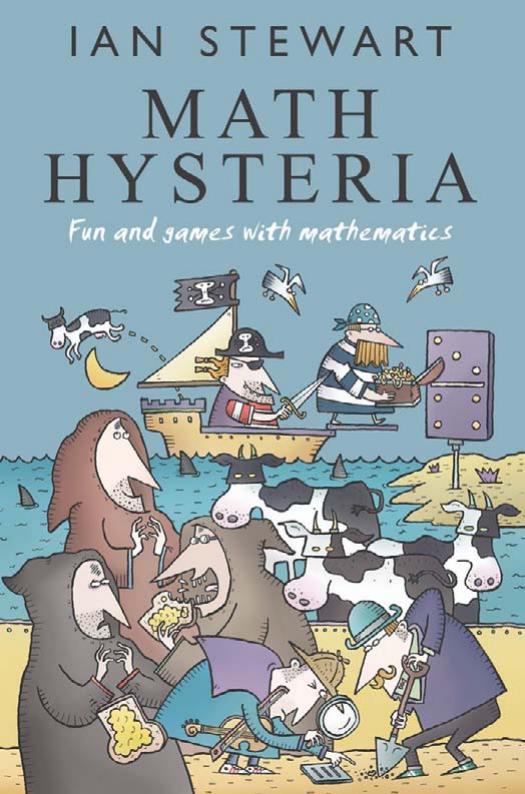Math Hysteria by Ian Stewart;

Author:Ian Stewart; [Stewart;, Ian]
Language: eng
Format: epub, pdf
ISBN: 9780198613367
Publisher: OxfordUP
Published: 2004-09-15T05:00:00+00:00
A Guide to Computer Dating
If you think our usual calendar, with its funny rules for leap years, is complicated, what about the old Hindu calendar, based on a cycle exactly 1577,917,500 days long? Or the Chinese calendar, where a year can contain 12 or 13 months? Why are there so many calendars, and why is every one of them a compromise? Because a calendar that matches the true cycles of the heavens is a mathematical impossibility.
In 46 BC the Roman calendar was getting out of synch with the seasons. On the advice of the Greek astronomer Sosigenes, Julius Caesar introduced an extra day into every fourth âleapâ year to make the average length of the year 365¼ days. Misunderstanding the rule, his priests counted the fourth year of one cycle as the first in the next, so every third year became a leap year. The mistake wasnât fully sorted out for 50 years. For all our supposed sophistication, we have not learned from Caesarâs priests, as is shown by the tale of the âMillennium Bugâ, in which it turned out that the majority of the worldâs computers were incapable of coping with any date after 31 December 1999, interpreting 2000 as 1900. In fact, most of them â the ones using the most popular operating system â couldnât even cope successfully with the correct rule for leap years. In the event, planes did not fall out of the sky at one minute after midnight on 31 December 1999, as widely predicted. Oh, and the actual millennium started on 1 January 2001, not 2000, because there was never a year zero, but most people dislike being reminded of that.
We need not make the same mistake again. About ten years ago Nachum Dershowitz and Edward M. Reingold of the Department of Computer Science, University of Illinois at Urbana-Champaign, decided to develop calendar and diary features for the Unix-based editor GNU-Emacs. Out of this project grew a unique resource: computer code for converting dates from one calendric system to another. The 14 calendars they decided to cater for are the Gregorian, ISO, Julian, Coptic, Ethiopic, Islamic, Persian, BaháâÃ, Hebrew, Mayan, French Revolutionary, Chinese, old Hindu, and modern Hindu. Their book Calendric Calculations (Further Reading) is an absolute goldmine for chronologists.
Calendars vary from culture to culture because they are all attempts to perform the impossible: to rationalize the irrational. Our units for time are based on three distinct astronomical cycles: the day, month, and year. A normal 24-hour mean solar day is the period between successive occasions when the Sun is overhead. (One rotation on its axis, relative to the âfixed starsâ, takes 23 hours 56 minutes and 4 seconds â but the Earth is also revolving around the Sun, and it takes a further four minutes for the extra rotation to compensate for the Sunâs apparent slippage across the sky.) The period between successive new moons is the mean synodic month, which lasts 29.530588853 days. The period required for the Sun to return to the same position in its apparent path is the mean tropical year of 365.
Download
This site does not store any files on its server. We only index and link to content provided by other sites. Please contact the content providers to delete copyright contents if any and email us, we'll remove relevant links or contents immediately.
The Infinite Retina by Robert Scoble Irena Cronin(5671)
Harry Potter and the Cursed Child: The Journey by Harry Potter Theatrical Productions(4327)
The Sports Rules Book by Human Kinetics(4099)
Molly's Game: From Hollywood's Elite to Wall Street's Billionaire Boys Club, My High-Stakes Adventure in the World of Underground Poker by Molly Bloom(3351)
A Knight of the Seven Kingdoms by George R R Martin(3035)
Quidditch Through the Ages by J.K. Rowling(3010)
How To by Randall Munroe(2929)
Quidditch Through the Ages by J K Rowling & Kennilworthy Whisp(2883)
Quidditch Through the Ages by Kennilworthy Whisp by J.K. Rowling(2762)
Flowers For Algernon by Daniel Keyes(2760)
Quidditch through the Ages by J. K. Rowling(2718)
Stacked Decks by The Rotenberg Collection(2706)
Quidditch Through The Ages by J. K. Rowling(2684)
776 Stupidest Things Ever Said by Ross Petras(2590)
Ready Player One: A Novel by Ernest Cline(2580)
What If?: Serious Scientific Answers to Absurd Hypothetical Questions by Randall Munroe(2552)
Beautiful Oblivion by Jamie McGuire(2484)
The Book of Questions: Revised and Updated by Gregory Stock Ph.d(2453)
Champions of Illusion by Susana Martinez-Conde & Stephen Macknik(2334)
